The LIV Hospitality Design Awards have announced the winners of its fifth edition, marking the most successful year to date. This edition has recognized exceptional architectural ventures and interior design projects that are reshaping the global hospitality industry, with a record-breaking number of submissions from talented professionals and emerging designers worldwide.
The jury panel, composed of experienced architects, designers, and developers in the hospitality sector, meticulously reviewed over 550 applications from 58 countries from Sri Lanka to Kazakhstan, from Canada to Mexico. The most outstanding projects in each category were selected, highlighting the diversity and creativity that define the future of hospitality design.
In the architectural category, Canopy: A treetop dining experience by Rock Venture Co. was awarded Architectural Design of the Year for Eating Spaces. Located at Anantara Golden Triangle, this dining concept is perched 52 meters high, offering panoramic views of Thailand’s border with Myanmar and Laos. Inspired by local beehives, its bamboo-clad capsule provides an immersive nature experience. Dialogue with Nature—Commune STORE by Atelier Global Limited, led by Frankie Lui and Cai Chao, won Architectural Design of the Year for Living Spaces. Situated in Houyuan Village, China, this project transforms an abandoned school into a community hub celebrating local rice culture. Using sustainable materials, it integrates into the landscape while revitalizing traditional farming practices.
For interior design, Uma Nota by The Odd Duck Design and led by Asmaa Said and Ellina Komarova, received Interior Design of the Year for Eating Spaces. This Japanese-Brazilian restaurant in Manila blends art, design, and ambiance across its multi-themed dining spaces, capturing the cultural fusion of São Paulo’s Liberdade district. Nanjing Back To Yaxi Manor Resort by YuQiang & Partners secured Interior Design of the Year for Living Spaces. This tranquil retreat in China features natural materials like rammed earth and bamboo, crafting serene spaces that harmonize with their surroundings.
The emerging talent category highlighted fresh innovation. Tasneem Hamza of Applied Science Private University was named Emerging Architect of the Year for Living Spaces for Bridging The Divide, An Urban and Architectural Dialogue for Fostering Community and Urban Vitality, a project reconnecting divided urban spaces in Irbid, Jordan, through revitalized heritage buildings. Jihyeon Park from Art Center College of Design earned Emerging Interior Designer of the Year for Eating Spaces with Limen, A Place Where Time Stands Still, a transformed historic train station in Pawtucket, Rhode Island, designed to evoke nostalgia and timeless beauty. Levi Lu, also from Art Center College of Design, was awarded Emerging Interior Designer of the Year for Living Spaces for Lianin, a Singaporean beachfront resort reimagining Peranakan culture through a modern lens.
Founder of the LIV Awards, Astrid Hébert, expressed, “We’re excited to see the fifth edition of the LIV Hospitality Design Awards come to such a successful close. This milestone celebrates the incredible talent shaping hospitality design today and marks a new chapter for us. For the first time, our awards ceremony will be held outside of Europe, in Shanghai this April. As we continue to grow, we remain committed to celebrating creativity, innovation, and the power of design to transform experiences. We look forward to celebrating with our winners in person and seeing how hospitality design evolves worldwide.”
The LIV Hospitality Design Awards continue to be a leading force in the hospitality design world, offering unrivaled recognition to designers who elevate the guest experience and redefine industry standards. Winning a LIV Award brings invaluable exposure, opening doors to new opportunities and cementing a designer’s place among the global elite. Congratulations to all the winners of the fifth edition!
For more information about the LIV Hospitality Design Awards, visit livawards.com.
The LIV Hospitality Design Awards, a globally recognized platform celebrating excellence in hospitality architecture, interior design, and guest experiences, proudly welcomes a new panel of esteemed jury members who bring a wealth of expertise to the competition.
Joining the jury are Arturo Sims, Managing Partner at VHC Global; Beatriz Carreto, Senior Design & Technical Manager at Radisson Hotel Group; Jamnary Moreno, Director of Interior Design for Global Luxury Brands at Marriott International; Mark Eacott, Global VP of Design at Ennismore; Corinna Kretschmar-Joehnk, Founder of JOI-Design; and Chiara Calufetti-Lim, Principal and Studio Director of Architecture at WATG. Also joining the panel are Francisco Lopez-Cordoba, Vice President, Interior Design, Design Services – Global at Four Seasons Hotels and Resorts (United States); Raul Tellez Casado, Director of Product and Design Area at Minor Hotels (Spain); and Carl Wee, Vice President of Technical Services at Wyndham Hotels & Resorts (Asia Pacific, Singapore). Their diverse backgrounds and perspectives will ensure a comprehensive evaluation of the innovative entries submitted for consideration.
These new jury members will join an impressive lineup of established jury members, including Luis Galofre, Chief Executive Officer at Talentchef Consultant Agency; Monika Moser, Former Chief Operating Officer at Campbell House; Ivo Christow, Head of Design at Krucker Partner AG; Bittor Sanchez Monasterio, Global Vice President of Design at Accor; Najee Syriani, Hospitality Development Director at Diriyah Company; Cristiano Pistis, BU Director of Hospitality and Luxury Residential at Eclettico Design | Lombardini22; Federico Toresi, Global VP Design for Premium Brands at Accor; Anne Faherty, Founder of Anne Faherty Interiors; Eric Leong, Vice President of Design & Technical Services at Minor Hotels; Sarah Smallwood, Design Director at Great Wolf Resorts; Larry Traxler, Senior Vice President and Global Head of Design at Hilton Worldwide; Barend Slabbert, Senior Lecturer in Interior Design at the University of Derby; and Kristina Belyavskaya, Founder of Cospitality.
Astrid Hébert, Co-founder of the LIV Hospitality Design Awards, expressed her enthusiasm, stating, “We are thrilled to welcome such a diverse and talented group of jury members this year. Their extensive experience and unique perspectives will undoubtedly enrich the evaluation process and elevate the awards to new heights.”
Chosen by a panel of esteemed professionals including architects, designers, hoteliers, developers, and leaders in architectural and interior design, the annual award winners have the chance to make their mark.
Submissions for the awards are now open, offering the opportunity to secure the renowned LIV Awards trophy, receive widespread international exposure for exceptional designs, and access a range of exclusive privileges, with the final deadline set for December 15th, 2024. For more information and to begin the submission process, please visit the official website at livawards.com.
Can you tell us about your background? Where did design first make an appearance in your life and how did you follow it?
Both of my parents were musicians. My mother was a pianist and my father a singer – a tenor – and both taught students in their master classes at a musical high school in my hometown. So my brother and I were raised in a household full of creativity: my parents’ students sometimes stayed overnight, there were often house concerts, and we, of course, also learned to play instruments, the two of us. But there was a special point where I was sure I would love to be creative but not ‘just’ for a moment on stage (after practising within my own four walls for hours every day). Even today I still love concerts, but I discovered another way to express my creativity, one that lasted longer than just a moment in time. I chose art as the main subject for my Higher School Certificate, first studying art history. Then, early on, changing to interior architecture – as this had already been my secret dream for a long time. In the end, it was my mother who encouraged me to go in this direction, because at first, I wasn’t sure if I should ‘only’ do something that, in my opinion, contrasted so deeply with music. My parents could touch the hearts of their audience with their music and help people feel better. But my mother convinced me to do what I loved, pointing out that the living environments I created would also help people feel better. Plus I loved to draw and sketch – when studying, I was already sure this was my dream job! And it still is.
What would you say is your personal design philosophy and how has it evolved throughout the years?
Arising from this wish to design nicer environments that help people feel better, my personal goal and mantra (I am a passionate yogi) has always been to design as a human for other humans. The only way this has changed is when my business partner and husband Peter and I founded our own studio with our maxim that we, as a team, are a group of individual personalities designing hotels for groups of other individuals. The sense of ‘humanity’ has always been my focus, so I’ve remained loyal to what I wished for from the very beginning. To me, this is what it’s all about, making the world a better place, step-by-step, each day. And, of course, this process is always evolving since each day we confront different, ever-changing circumstances and challenges.
Can you tell us about the story behind the creation of your studio JOI-Design?
JOI-Design – looking at the name, this is a nickname, an acronym of ‘joehnk. interior design’ – the company we come from and which has our surname ‘Joehnk.’ Hospitality design has always been in our DNA and is a topic we enjoy focusing on. We love this industry, although it is challenging due to budgets, and of course time schedules, since everything is based on a certain return on investment. When designing ‘signature’ office spaces – which in recent years have become a new pillar of our portfolio now that once-separate living environments merge ever-closer together – we often experience more creative freedom. Sometimes these are ‘once in a lifetime’ projects for a brand where return on investment doesn’t play as important a role, plus clients are willing to wait a little longer for everything to be exactly right to best represent their company’s identity.
But we love hotels! We love their vibe – locations where people from all over the world meet and mingle, and get inspired. Peter founded the company 40 years ago. I joined as an employee in 1993 and – to make a longer story short – we joined forces and together founded the studio with the JOI-Design nickname to continue what Peter once started. The longer version of the story also includes a bankruptcy 20 years ago when ‘9/11’ made us unsure that we could overcome the crisis of no one wanting to build hotels anymore. Hard and uncertain times… But we didn’t lose our positivity: we started anew, from scratch, and together – the two of us. And somehow it all fell into place. Step by step, we could grow again. We learned the lesson that you have to stay true to your own values. You have to stay honest and that is all you need! For example, one client said to us – and we loved it, “It’s not your company that doesn’t exist anymore – it’s you – it’s all in your heads – and I want you!” So it turned out not to be a problem that our former company no longer existed. And therefore we started again, changing our company to our nickname.
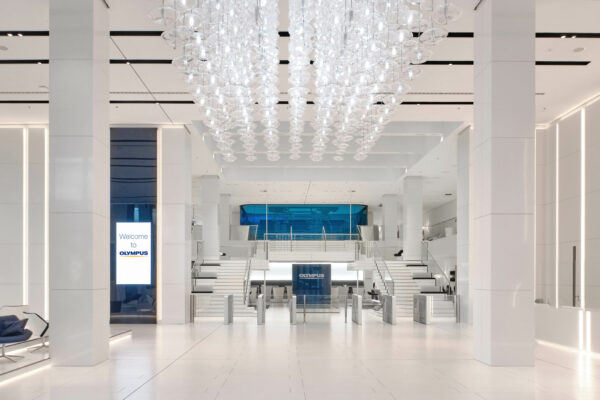
JOI-Design, Olympus Campus Hamburg. Credits: Christian Kretschmar for JOI-Design.
Your studio is known for shaping luxurious atmospheres for a variety of properties. Can you describe some of the biggest projects you’ve worked on and the process your team follows to create a new design?
We began with smaller boutique hotels before moving into the design of more complex developments. Although these privately owned boutique destinations were our foundation, we still treat every larger project as an individualised concept and not part of, for example, a larger hotel chain.
Some of our key projects in recent years—though this is just naming a few, which isn’t easy as each project becomes our favourite—include:
A big resort in the south of Germany, the hotel ‘Der Öschberghof,’ where we worked on a complex renovation, revitalization, and extensions. It features a 5,000-square-meter spa, various individual dining options, a large inspiring conference space, and, of course, very special guestrooms and suites inspired by the surrounding countryside.
The second project I’d like to mention is quite the opposite: an urban hotel in our hometown that is just as luxurious as the countryside resort. The Fraser Suites Hamburg involved the major conversion of a former office building, made even more challenging by its earlier use as a tax office, which was designed not to feel inviting but to command respect from the local citizens who paid their taxes there. This listed monument, built 100 years ago, revealed hints of its past in the form of floor tiles unearthed during the renovation. These guided us toward our new design concept, reawakening the spirit of the building’s construction era with inspiration from the Roaring Twenties. This project presented a different challenge: accompanying this ‘grand dame’ into her next chapter by adding new layers, polishing what was worthy of preservation, and giving her a bit more sparkle to become a luxurious hotel.
My third example of our recent work is a small but lovely jewel on the island of Sylt—known as the ‘Hamptons’ of Germany. The ‘Söl’ring Hof’ has only 15 guestrooms and suites, all unique, with some being maisonettes. The hotel has a strong culinary focus, run by a talented young chef and a creative sommelière. We began our renovation step-by-step, first revamping the fine dining restaurant—which has already received two Michelin stars—by giving it a new soul and character while increasing interaction between guests and the restaurant team for an immersive culinary experience.
How do we work? We always deep-dive from scratch as we launch into new adventures: our team is experienced with the topic of ‘hotels’ – so this is our base and foundation – and then from there we can play and always invent something new that works because we stick to certain rules a hospitality project should follow: of course these have to do with time and money (which, as I mentioned before, are sometimes different for office projects) – but for us, this also means being sustainable by picking materials that are durable and endure.
This leads me to one more final project that we recently completed, the creation of a new hotel brand whose DNA is based on ESG principles: THE USUAL, with the first in this new hotel chain having just opened in Rotterdam. It’s already shortlisted for some awards because it is special and new. It took all of us – the client plus our team of designers – to identify certain boundaries and recognise that overall, the hotel industry is still not where it should be with sustainability. It lacks overall guidelines comparing what is truly sustainable and what is not – there are so many different points to consider. But in the end, we created something special – that’s for sure – and we are really happy that on top of all that, we have created a space where social interaction is encouraged and openly wanted. This became really crucial to our plan, because it, too, is very sustainable since its effects will last – it’s not just about materiality. So the circle closes: designing being humans for humans.
Apart from luxury hotels, your studio also works with the cruise industry. How did JOI-Design enter this niche, and what are the challenges this area encompasses when compared to land-based hospitality projects?
There are two reasons we entered into this new field: one was that Peter, in his early years, founded a company that focused on designing for the cruise industry – so he already has a degree of experience, but then he stepped away a long time ago to concentrate on ‘his’ hotels again. Also, I worked for a client and a hotel in South America, in Chile. This client became COO of a cruise line and then, 20 years after our first project, called me and asked, “Are you interested in bringing your experience from land-based hotels to the cruise industry?” Of course, I was!
Naturally, there were challenges: a ship is made of steel instead of concrete and bricks. Weight plays a bigger role, space is more limited, and above all, the rooms’ ceiling heights are not that high. Fire and life safety must be considered differently. And that’s only to name a few of the differences… In the end, though, on cruise ships, we create inspiring living spaces that make the clients of our clients feel better – like they’re in a hotel on land. Concerning creativity, the most different starting point is that at the beginning, we don’t have a location to reference – because the ship is moving from port to port. But this is a very nice challenge too – and we’ve already found some answers…. Challenges keep us alive.
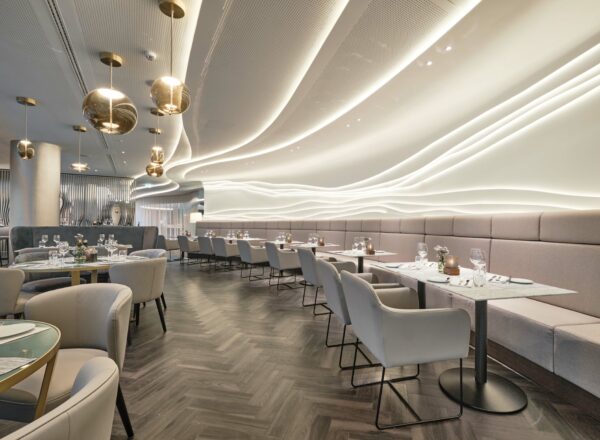
JOI-Design, Steigenberger Hotel Hamburg. Credits: Christian Kretschmar for JOI-Design.
During your lectures at universities, what key lessons do you emphasize to prepare the future of design for success?
I always preach: love what you do! Then you can be the best! Stay curious and think sustainably!
Can you tell us about a particularly memorable project you’ve worked on that you still think about to this day?
I would say one of our initial boutique hotels that is owned and run by a lovely couple in the Black Forest: it’s called ‘Hotel Ritter Durbach’. We already had a project in common, a hotel on the island of Rügen in North East Germany where they were general managers but didn’t own it. A few years later, they called and told us they’d bought their own hotel in the south, and from then on, we created everything collectively with super teamwork. They brought in their ideas and we fought about budgets together – because most of the time, nicer things are more expensive – but they had just begun their business and had to look after their money. However, the result was simply stunning! Everybody was happy! They even gained a Michelin star with their fine dining restaurant and were so successful that they built an extension (also designed by us). And yes, and we are still connected.
As a jury member for the LIV Hospitality Design Awards, what do you prioritize when evaluating designs?
I don’t have a recipe or strong rules. It’s like when we’re brainstorming at the beginning of a project and starting to create the story: I always ask – does the story touch your heart? Is it relevant for our times and the demands of society? And then is there a strong emphasis on sustainability on top of that?
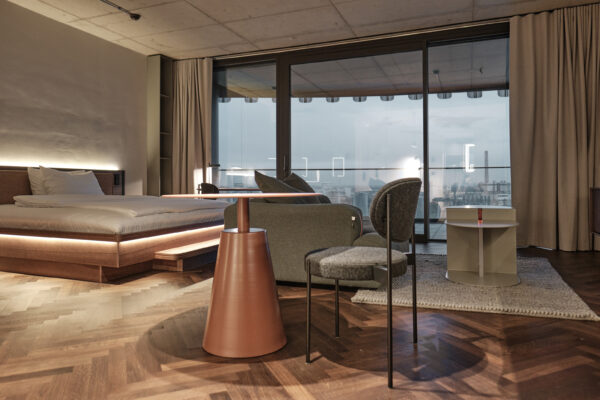
JOI-Design, The Zipper. Credits: Christian Kretschmar for JOI-Design.
What do you envision for the future, both for yourself and for the broader design community?
I would love to see more collaboration across the whole scene! Teamwork makes the dream work – and we all can be stronger. We also discovered this when cooperating on special projects with colleagues from other firms in our interior design circle. You always learn and gain so much! This is the future for me. We are not made to ‘fight’ for us alone.
Welcome to our exclusive interview with Jiin Park, the emerging designer behind Radiant, the wine-tasting restaurant recently awarded the prestigious Emerging Interior Designer of the Year – Eating Space title.
A student of the Art Center College of Design, Jiin designed Radiant to be a dining destination and a sensory journey through the phases of the sun, where guests indulge in unforgettable wines and gastronomic delights. She integrates shifting colours, natural light, and spatial dynamics to elevate the wine-tasting experience to an art form.
Join us as we dive into Jiin Park’s creative process and inspirations, and learn more about her journey.
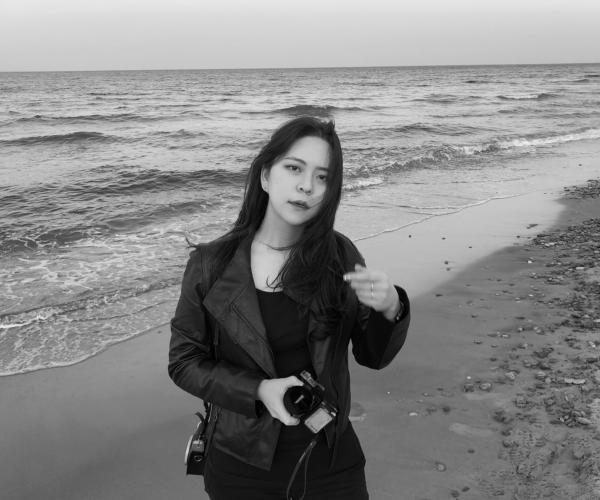
Jiin Park
Can you start by telling us a bit about yourself? How did you discover design?
I would say I see myself as a storyteller. Storytelling is key to design, viewing every space as a canvas to inspire, evoke emotions, and craft lasting memories. As a designer, I aim to create meaningful connections on both emotional and intellectual levels, enriching each space with distinctive narrative depth and a commitment to enhancing spatial experiences.
My design journey began at an early age heavily influenced by my mother, an artist, who inspired my appreciation for good sense and sparked my interest in various forms of art, including fine arts, interiors, and fashion. My passion for design deepened throughout my life, making me pursue more dedication in design. After high school, I spent two years exploring different fields and gaining real-world experience. These diverse experiences were crucial in helping me discover my passion for designing meaningful spaces that positively impact users.
This exploration and engagement with the real world and the people were pivotal in shaping my approach to design. Design, to me, is about recreating life experiences and memories. It’s about creating spaces that not only capture the essence of these experiences but also enhance the human experience, making each interaction within them meaningful and transformative.
You describe your project as a restaurant “that offers a savoury journey through the sun’s phases”, it’s quite a fun concept! How did you come up with this vision?
I believe that inspiration often comes from observations of everyday life. Particularly, my love for wine and daily inspirations laid the foundation. Developing the project, I explored how wine is different from other drinks and what makes it unique. For many people, wine is more than just a drink. It’s a portal to cherished memories and often ties back to a special moment in time. Wine is a medium of bonding, special moments, and beautiful memories. The experiences shared through wine enhance the romance and richness of those moments.
While conceptualizing the project, I was inspired by the simple method of categorizing wine by colour, aiming to design spaces that convey emotional and romantic vibes. Particularly, Galileo Galilei’s quote, “Wine is sunlight held together by water,” provided significant inspiration. This quote made me think about how the sun’s changes and the colours of the sky relate to the various hues of wine. This insight led me to reflect on these changing colours and moods in the space, depending on the sun’s phases, to enhance the wine-tasting experience.
Times like sunrise and sunset are often considered romantic and emotional atmospheres. By integrating natural rhythm into the project, I aimed to emphasize each wine’s unique characteristics and provide visitors with a special experience that blends seamlessly with these moments. ‘Radiant’ is based on this thought, transforming beyond a simple restaurant into a space that offers a memorable savoury journey. Throughout this project, I focused on linking the sun’s romantic and emotional qualities to develop it further. This approach demonstrates how memories and moments come alive within the space, emphasizing the emotional experiences generated in the process.
Turning your imagination into reality can be the hardest part of any artistic job. Can you walk us through your creative process and how you approach your own creativity?
I think much inspiration comes from everyday life. There’s a lot of inspiration around us, but the same thing looks different when we pay attention to it. For example, looking at wine a bit differently and writing poetry about it can make you a poet, and creating music turns you into a musician. We need to take a closer look at a subject and say, “Why don’t we connect it with a different perspective, whether it’s a space, furniture, or a product?” I believe that fresh and good design comes from connecting things that already exist and looking at them from a new perspective. My projects show how I’ve connected different stories from everyday life with design.
So, at the beginning of a project, I expose myself to a variety of related materials. This includes everything from reading books, watching films, and seeing interviews, all focused on gathering inspiration. During this process, I think deeply about how to connect those inspirations to my project, such as the target audience or site characteristics.
From there, I set the project’s direction. Depending on the project’s characteristics, I decide which part of the research to emphasize and figure out the most effective approach to guiding the project’s direction. For each project, I establish a central keyword or phrase that helps the entire development process. And this approach I think, is similar to a branding process. This keyword captures the essence of the project and clarifies the overall design and development direction. This also helps weave all detailed elements within the space into a single narrative, considering the sequence and emotions that users might feel when they experience the space. I believe this systematic approach helps each project go beyond aesthetics and design visitors a deeply resonant narrative experience.
Natural light and colours share the spotlight in this project, alongside wine, of course. Can you elaborate on their role and what you envision a guest’s experience would look like in the restaurant?
In the “Radiant” both natural and artificial light play crucial roles in maximizing the wine-tasting experience, engaging all senses during the tasting. Guest circulation is designed to allow visitors to experience different stages of the day as they move through the space. Also, the interactions of colour through the choice of materials and lighting contribute to the visual perception of wine and space.
For example, spaces incorporating natural light have angled walls to allow people to observe how the sun changes throughout the day. For the wine party area, inspired by sunset, select design elements that do not harm functionality. Wall-wash lighting on slanted walls gives a sense of grandeur to elevate the party atmosphere, while rounded ceiling fabrics soften the atmosphere. Inspired by dusk, the bar and lounge area are designed with a curated colour palette and soft velvet texture that focuses on the emotional and sensory aspects of wine tasting. Colours like purple, burgundy, blue, and grey are used with soft and comfortable materials to create an intimate atmosphere that encourages guests to focus on the wine.
All these elements are harmoniously combined to provide users with romantic, sensory exploration, and transformative experiences at specific times of the day. This approach extends wine tasting beyond taste to include visual and tactile elements, offering visitors memorable and unique moments.
Which challenges were you faced with while working on the project? As a great source of knowledge, you must have learned a lot from them. Can you let us in on a lesson taken from this project?
One major challenge was to preserve the original site’s buildings as much as possible effectively while utilizing natural light, Existing building barely had windows, but since sunlight was crucial to the project, I chose to use a long slim slit in the ceiling to bring light effectively. Considering where the sun shines for the longest periods, I determined how to allow natural light through the ceiling opening, creating interesting light patterns throughout the day. Also, to have one linear shape light without sims, I came up with a structure solution using a cantilevered ceiling with metal beams and tilted walls. An important lesson learned from this project was the importance of flexibility and creativity to overcome technical constraints while preserving creative vision.
Aside from the project itself, two weeks before the final, I ran into an accident in the school model shop. I injured my finger on a disk sander, had to go to the ER, and nearly had to return to Korea. Despite this tragic situation, I was able to finish the project thanks to the encouragement and support of my professors and friends. This was a huge experience in my life and reminded me of the importance of perseverance and focus to complete a project successfully.
Did you get to apply any theory you learned at your university, the Art Center College of Design? How do your studies affect your approach to design?
Definitely! My studies at ACCD (Art Center College of Design) have greatly influenced my design philosophy, which emphasizes the integration of form, function, and storytelling. The theoretical knowledge I gained was instrumental in conceptualizing “Radiant.” Our school has allowed me to create designs that are not only aesthetically pleasing but also functionally deep and contextual.
Also, storytelling has become a pillar of my design approach, allowing me to weave rich narratives into the fabric of each space. For example, in the “Radiant” project, a narrative about the phases of the sun and their impact on the wine-tasting experience became a central theme. This approach not only makes the environment more engaging and memorable but also strengthens the emotional connection between the space and its visitors. By incorporating storytelling, my designs fulfil both aesthetic and functional needs while enriching the overall user experience to resonate on a deeper level.
Congratulations on winning the Emerging Interior Designer of the Year for Eating Spaces award at the LIV Awards! How does it feel to be recognized at such an early stage of your design career?
I am truly honoured to receive this award and win the Emerging Interior Designer of the Year for Eating Spaces. This award is not only a recognition of my approach and dedication to design but also a confirmation that my creative approach is gaining resonance within the industry.
This encourages me to continue pushing my creative boundaries and explore more innovative concepts. Being recognized by industry leaders gives me confidence and willingness to take on bigger and more challenging projects. It also gives me a greater sense of responsibility to set higher standards for design, striving to create spaces that not only meet aesthetic and functional requirements but also have a positive impact on the lives and environment of their users.
We can’t wait to see what the future holds for you! Can you tell us about a dream of yours? Perhaps a vision or a dream studio you would like to work with someday?
As an early-stage designer, I am eager to collaborate with a variety of professionals to broaden my skills and perspective.
My ultimate goal is to become a pioneer in the industry, creating spaces that combine branded experience and hospitality elements to create lasting memories and enhance interactions. My goal is to not only connect people through design but also to create stories in space that inspire and motivate, transforming everyday spaces into environments of joy, discovery, and connection.
Regarding my dream studios, while I am familiar with American firms, my time as an exchange student in Europe also sparked my interest in developing my career there. I am drawn to hospitality-focused firms like AvroKo, Yabu Pushelberg, Rockwell, and HBA, as well as commercial design studios like PlayLab, Gradient, and WGNB. I admire the work of Danish designer David Thulstrup and Korean designer Jonghwan Baek, and I would love to explore opportunities to work with or learn from them.
Welcome to an exclusive interview with Anna Burles, the Lead Designer and Co-Founder of Run For The Hills, a renowned multi-disciplinary design studio based in London. Anna spearheaded Audrey Green & Larry’s Bar design, situated within London’s iconic National Portrait Gallery, which recently won the Interior Design of the Year – Eating Space award.
Audrey Green & Larry’s Bar combines contemporary aesthetics with the rich heritage of the National Portrait Gallery. With curated artworks celebrating London’s arts and music scene, including contributions from NPG curator Sabina Jaskot-Gill, artist Justin Hibbs, and Daisy Green owner Tom Onions, the space offers a unique, immersive experience for art enthusiasts and gastronomes alike.
Join us as we discover Anna Burles’ creative process, insights, and the inspiration behind Audrey Green & Larry’s Bar.
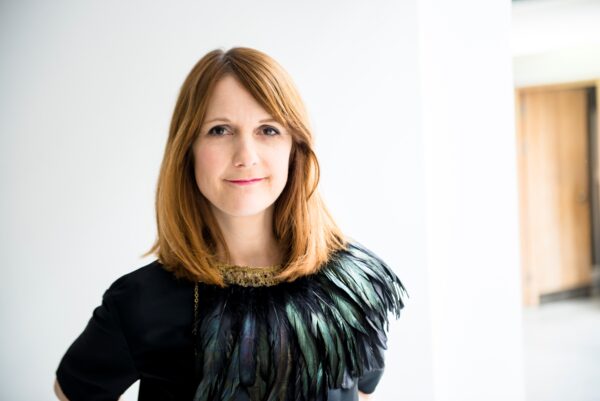
Anna Burles
Let’s start by telling us a bit about yourself. Where did you grow up, how did you discover design, and how did it have such an important place in your life?
I grew up in the stunning national park of the Lake District in England, as far north as you can go before folk start talking Scottish. I came late to interior design, re-training at the age of 37 at the KLC School of Design in London’s Chelsea. Before that, I was an event stylist. And even further back, I worked at the BBC and spent a few years as a celebrity reporter, chatting to pop singers and film stars on the red carpet. So I’ve had lots of creative jobs, but I had an inkling that design was my thing and true enough, after training professionally in interiors I settled. I’d finally found my thing!
What was the vision behind this venue’s new design, and how did you bring it into reality?
It was a privilege to be involved with the rest of the Daisy team in the creation of Audrey Green and Larry’s Bar within such a stunning, landmark gallery. Our interior design needed to be an evocative part of the exciting new destination café/bar venue, but to also respect the fact that the art is the true hero as befits the Gallery location. Where else might you be sipping a delicious cocktail in the company of such amazing creative works from the gallery’s collection? Our interior design needed to talk to the building’s amazing features, but to let it shine. To draw people in, make them feel at home and truly inspired.
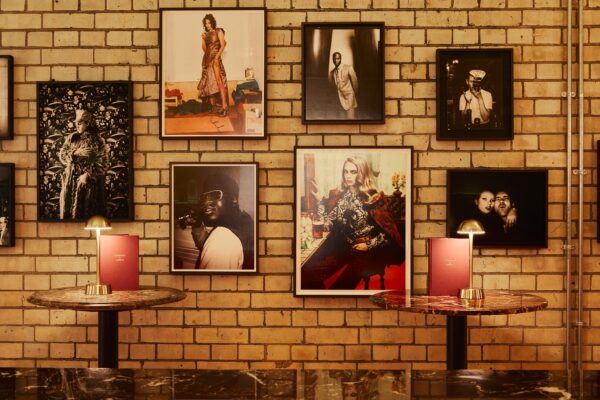
Photo Credit: Katya De Grunwald
The design is heavily inspired by ballet, and music using the archives of the National Gallery Museum and the internationally-loved movie Breakfast at Tiffany’s. How did you incorporate such rich subjects into the design, and how did your personal style come into play?
Daisy Green collection venues are always art-filled, usually featuring works from the private collection of owners Tom Onions and Prue Freeman. For Audrey Green and Larry’s Bar, the walls are decorated with works from the National Portrait Gallery’s world-renowned photography collection, with collections of stunning, iconic framed portraits and sculptures as far as the eye can see – and the art really is the heart and soul of the space. Tom’s research on Audrey Hepburn, Laurence Olivier, the West End, London and Soho served as the basis for the thematic selections.
A team of specialists, including National Portrait Gallery curator Sabina Jaskot-Gill, and artist Justin Hibbs planned the production from framing to the vast Salon Hangs; collaborating to bring the project to life. Celebrating the vibrant arts and music scene and diverse cultural icons of the area, depicted in a different, unique light. Ballet and fashion dress the ground floor while theatre, film and music adorn the Vaults downstairs in Larry’s Bar, creating a truly unique and immersive drinks and dining experience for art lovers in the capital.
The venue is comprised of a restaurant, a bar, and a ground floor café. Can you tell us about their design differences and what you like most about each space?
Audrey Green and Larry’s Bar have very distinct personalities. Audrey Green is ‘Breakfast at Tiffany’s’ inspired and bathed in natural light, occupying the ground floor of the gallery’s East Weston Wing. We love the fact that the space oozes history and grandeur, but is also now such a cool, contemporary and airy space. Accessed from within the Gallery and with its own street entrance on Charing Cross Road, Audrey Green serves speciality coffee, tea, sandwiches, brunch and cake to art lovers as they take a break from exploring the exhibitions and will also offer a weekend bottomless brunch. We used a peaceful materials palette, natural tones & textural upholstery to create a simple backdrop to the stunning art. Then added some accent seating fabrics with a 70s twist, to counterplay the classical backdrop, which fits beautifully alongside the modern photographic artworks.
Larry’s is downstairs, nestled and cocooned within the gallery’s ancient vaults. One side of the Deco-inspired bar is cocooned within the arches, making it beautifully moody by night. But the other side of the bar is drenched in daylight from a glazed ceiling that hints at the bustling street level above. Like Audrey, Larry’s is connected to the gallery but also has a dedicated street entrance from Charing Cross Road. We love the way Larry’s transitions through the day from light and fresh to warm, cosy and bar-fly moody.
We also love our curved, tiered booth seating, which we designed for Larry’s in a vibrant rich palette of tone-on-tone and colour-clash pinks and reds, in vintage velvets and textural weaves. Signature deco-curved, tiered backrests but with light and open bases, more like sofas, with turned timber legs adding a traditional wood-working twist. Our FF&E scheme is complemented beautifully by the art curation, with certain hero pieces framed by the specialist decorative wall finish creating curved forms behind works. We also designed intimate one-man booths for couples or singles, with charging points for visitors wanting to re-charge or laptops for a short while during their break from the galleries.
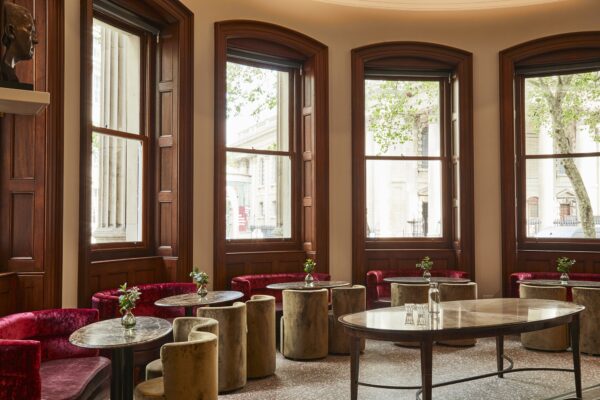
Photo Credit: Katya De Grunwald
You decided to keep the historic architecture and mosaic floors, enhancing both with elements such as a marble coffee counter, artwork, and furniture. Can you tell us how you were able to craft such a seductive atmosphere while maintaining the original characteristics of the space?
We were truly blessed to have the historic backdrop of the building – both in the cafe with its beautiful arches and curved rotundas. The cafe also has striking restored shutters around picture windows with views onto Charing Cross Road and beautiful heritage architectural covings. We felt it was important to celebrate every inch of history and then juxtapose these classical elements with contemporary finishes. So Audrey’s swirling statement coffee bar has a beautiful veined marble counter with an unexpected soft concrete fluting.
But then Larry’s Bar is also a marvel bursting with character – set underground, within the restored brick vaults, designed into the fabric of the National Portrait Gallery. The perfect home for creating an atmospheric drinks and dining hot spot. We created cosy corners and private nooks for guests to get lost in, with Intimate booths designed into the individual arches of the rotunda in a mix of rich velvets and leather for intimate get-togethers with friends and romantic date nights.
What were the biggest challenges your team faced with the project? How did you overcome them, and what did you learn from this project?
With any historic building, the design process is multi-layered and needs to be run via heritage consultants and multiple stakeholders. The Gallery was also passionately involved in the process, so this was a new experience for sure. The Project was full of little challenges, but all the sweeter when a solution was found. Adding lighting to historic brickwork without being invasive, using inventive ways to disguise heating and aircon within furniture and generally protecting heritage features at all times. Even considering how to cater for the very broad guest audience of such a famous Gallery was a learning. The spaces are also quite narrow, so the ultimate challenge was to create not just a stunning space, but also comfortable and welcoming spots for small & large groups to gather for both short pit stops and longer lazy lunches and dinners.
Congratulations on winning the Interior Design of the Year for Eating Spaces award at the LIV Awards! How does winning such accolades influence your approach to new projects?
Winning any kind of award and being recognised for your work means the world to us in the studio. We love what we do, and we hope it shows and getting a nod makes all the hard work worth it. We have an amazing team behind me and my brilliant husband and Co-Founding Creative Director, and Run For The Hills is a boutique, family design studio. So we are utterly delighted and humbled to have won the Interior Design of the Year. We’re also grateful to our clients at Daisy Green for encouraging us to let our creative juices run riot. And to the art curation team for their amazing work – it is really awe-inspiring and supercharges our design on every level, so we doff our hats.
We can’t wait to see what the future holds for you and your studio, Run For The Hills! Can you tell us about new projects you’ve been working on or any recent inspirations?
We have lots of exciting projects on the go, an Italian restaurant with a secret Garden Bar in the Middle East, our first Japanese F&B design and also a stunning Grade II Listed luxury guest stay in the English Countryside. We’re also designing the homes of some wonderfully talented actors and singers and our graphics team are creating brands and collections of bespoke art for hotels and restaurants. So it’s go-go, but all good in the land of RFTH.
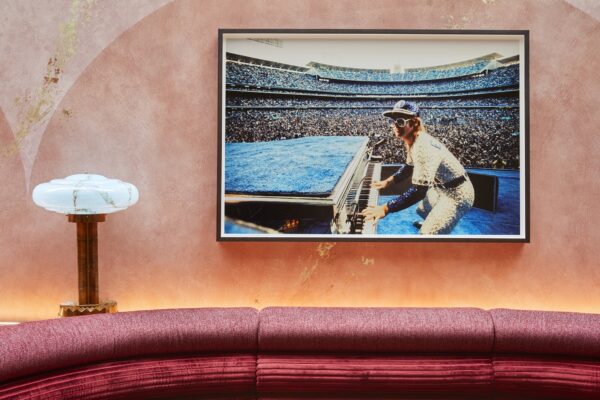
Photo Credit: Katya De Grunwald
Meet Michael Schickinger, the creative director behind the award-winning Lambs and Lions design studio whose team specializes in crafting holistic experiences through hospitality design, art direction, and strategic branding.
Following their win at the LIV Hospitality Design Awards, where their project, OKU Kos, took home the award for Interior Design of the Year – Living Space, Michael sheds light on the project’s inspiration. This stunning beachfront resort, with its minimalist aesthetic and village-inspired layout, embodies the studio’s dedication to crafting poetic, intuitive architectural solutions imbued with serenity and warmth.
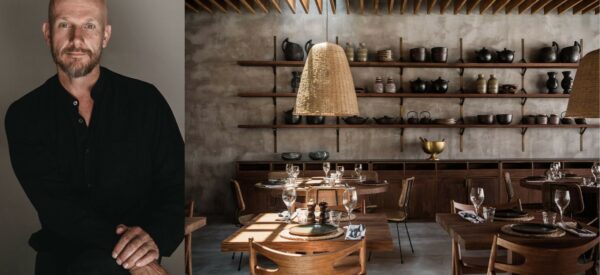
Michael Schickinger // OKU Kos, OKU Hotels
Can you start by telling us a bit about your background and passion for design? How did design come to have such an important place in your life, and what’s your personal life philosophy?
As a creative director, with more than two decades of experience in the industry, I have dedicated my career and passion to crafting immersive narratives through design, art, and branding in the hospitality sector. I strongly believe that design in hospitality goes beyond mere aesthetics, it’s about creating a conversation with the guest, engaging with the local culture, and weaving a sense of place into every texture and object. There is this deep commitment to authenticity, the beauty in simplicity and a dedication to create meaningful experiences.
What was the vision behind this beach resort’s design, and how did you bring it into reality?
Our design philosophy is deeply rooted in the idea of creating meaningful spaces that enhance the human experience. Spaces that tell a story and connect people to their surroundings.
The site is located within a serene stretch of rural beachside on Kos, so we designed the retreat with a sense of community and slow living in mind. Akin to a historic Greek village and their labyrinth of cubist houses, a village-like feel was developed with a mix of one and two-story houses grouped around Mediterranean gardens and patios.
Inspired by the Greek philosophy of “Parea” we have created the hotel’s beach club in a more relaxed architectural style with large openings and a textured thatch roof. Retractable glass planes create an airy, open space that allows the guest a seamless transition between the tranquillity of the dunes of the beach and the relaxed energy around the main pool. As a result, community energy is felt in every part of the hotel.
The sense of relaxation is enhanced with a separate spa and well-being area which encompasses an indoor pool, treatment rooms, and a glass-walled sauna overlooking a lush courtyard, with views through to the domed hammam.
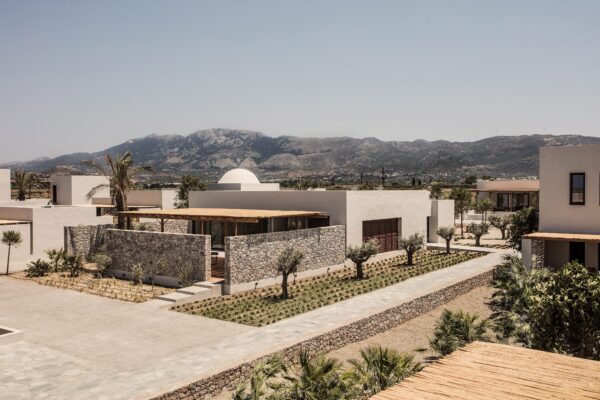
OKU Kos, OKU Hotels
The resort is modelled after the island’s traditional architectural style, ensuring consistency and respect for the native community. How does the interior design style portray the island’s culture, and how did you research it?
One of the key elements of our approach is the integration of nature and the local environment into the projects. We believe buildings and spaces should be designed with a deep respect for the natural world and work in harmony with its surroundings.
The interior design‘s use of rough, natural materials and earthy hues adds to the sense of relaxation, while its nod to midcentury design keeps the property well within the realm of contemporary.
Our studio has gained international recognition for its ability to blend contemporary design principles with local culture and history, creating spaces that feel both timeless and deeply rooted in their specific contexts.
Congratulations on winning the Interior Design of the Year for Living Spaces award at the LIV Awards! How does winning such accolades influence your approach to new projects?
We are deeply honoured to receive the Interior Design of the Year award for Living Spaces at the prestigious LIV Awards. This accolade is a testament to the passion, creativity, and hard work that our team, collaborators, and local craftsmen put into bringing the vision of OKU Kos to life.
Each project is a journey, and with OKU Kos, we aimed to create a space that not only stands out aesthetically but also resonates on a personal level with our guests, providing them with a tranquil yet engaging environment. Winning this award reinforces our belief in creating spaces that are in harmony with their surroundings, embodying a spirit of relaxation and community.
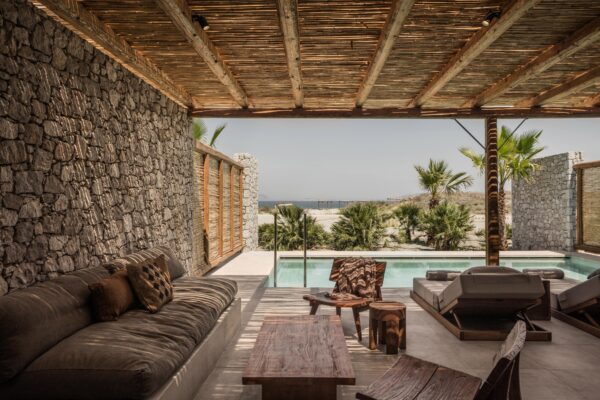
OKU Kos, OKU Hotels
We can’t wait to see what the future holds for you and your studio, Lambs and Lions! Can you tell us about new projects you’ve been working on or any recent inspirations?
We are currently working on various larger projects in the hospitality, residential, and commercial sectors. Some highlights include several Scorpios expansions in Bodrum and Tulum, which will be completed and opened this year. Other projects include residential properties in summer destinations and other Scorpios in Athens in a more urban environment, which is very exciting.
The 3C Awards honoured the BLT Built Design Awards and LIV Hospitality Design Awards 2023 winners during the two-day Asia Pacific Design Center (APDC) Awards event and conferences. Exceptional projects from the LIV Hospitality Design Award recognized at the Gala were:
The APDC International Design Awards Gala, held March 26-29, 2024 in Foshan and Shanghai, China, is a major annual event. Over a thousand design professionals from various countries participated, representing architecture, interior design, landscape architecture, and product design.
The Gala is a collaborative effort between APDC and numerous design award organizations, including the BLT Built Design Awards, the LIV Hospitality Design Awards, and others. It aims to recognize exceptional designers, discover new talent, and promote sustainable growth within the design industry.
During the event, Prof. Patrick Fong, the APDC International Design Awards Gala (2023-2024) chairman, announced that Ms. Astrid Hébert will take over as the chairman for 2025-2026. Ms. Hébert, a design industry veteran, previously served as an executive at the IDA International Design Awards in the United States and is the founder of the Swiss 3C Group, which oversees prestigious awards like the SIT Furniture Design Award, the LIV Hospitality Design Awards, the BLT Built Design Awards, and the LIT Lighting Design Awards.
The unveiling of each design award allowed attendees to witness the pinnacle of collaboration between Chinese and international designers. The Gala serves as a springboard for design talent, and organizers believe participation in influential design competitions is crucial for success. They look forward to more Chinese designers achieving recognition through the APDC platform and reaching the global stage.
Designer Mihika Chatterjee, a student of the New York School of Interior Design, has impressed the LIV Jury with her innovative project, Inter(Vo)ven. With this concept, she won the coveted title of Emerging Interior Designer of the Year – Living Space at the LIV Hospitality Design Awards 2023. The LIV Awards are renowned for recognizing excellence in hospitality design, and Mihika’s achievement showcases her creativity and forward-thinking approach. Inter(Vo)ven is a fashion hotel with a vision to connect the global fashion industry. It aims to achieve this by building a community of local and international designers. It provides a dedicated space for designers to stay, work, relax, and network. The aim is to ease travel for work and inspire creativity.
In this exclusive interview, we’ll dive deeper into Mihika’s award-winning project, explore how she used her design skills to create a space that fosters collaboration, and connection, and the significance of this recognition for her future endeavors.

Inter(Vo)ven, Mihika Chatterjee
Can you start by telling us a bit about yourself? How did you discover that design was going to be such an important part of your life?
My identity as a designer began to take shape at a very young age. I’ve always had an eye for detail, especially when it came to buildings and homes. As a child, I always found myself most interested in home decor magazines, fascinated by the intricacies of architectural design and the meticulous detailing of interior spaces. I was drawn to the creative and transformative power of design.
As I pursued my undergraduate studies in architecture and subsequently completed a master’s degree in interior design, I realized that design was not just a career path for me but a fundamental aspect of my identity.
Furthermore, I grew up in a family that specialized in manufacturing home furnishing products, it was only natural that I developed a passion for interior design. Assisting my family in crafting creative solutions for our furnishing needs, I honed my skills in detailing and problem-solving from a young age. This background further fueled my desire to become an interior designer, with a special focus on creating spaces that deeply impact the lives of those who inhabit them.
How did you come up with the vision for your project? Would you say you divide your passion between interior design and fashion?
Fashion, much like interior design and architecture, has always been a passion of mine. Having lived in New York for three years while studying interior design and attending summer school in both fashion and interior design in London, I have had the opportunity to learn from and be inspired by both cities. I believe my enthusiasm for interiors and fashion has always been intertwined. When I moved to New York, I quickly realised its importance in the global fashion scene, as it is one of the four major fashion capitals alongside London, Paris, and Milan.
New York hosts the New York Fashion Week every fall and spring. This event attracts designers from all corners of the globe to showcase their latest collections, drawing in buyers, journalists, celebrities, and top models. As the indisputable epicentre of the American fashion industry, designers visit New York year-round for inspiration, work opportunities, material sourcing, and to connect with suppliers and manufacturers.
Having attended numerous fashion shows in the past, I noticed a gap in the market for designers who frequently travel with their teams for work from around the world and the inconveniences they often face. This observation fueled my desire to bridge this gap. Motivated by this concept, I envisioned a centralized space in New York where all facets of the fashion industry could come together, simplifying work-related travel and, in turn, fostering a global community that promotes international collaborations among designers from different parts of the world.
I believe the fashion world lacked a space that could unite and connect the global fashion community. The project was designed with the idea that this concept could later be adapted as a model in the other three fashion capitals of the world, thereby forming a cohesive global network of designers.
How does the design of the Inter(Vo)ven help address the problems in the fashion industry and promote interaction between designers?
As I mentioned before, in my opinion, the fashion world was missing a space that could unite and connect the global fashion community, which was much needed. Inter(Vo)ven aims to act as that singular thread that brings the world of fashion closer together.
The concept of my design is to connect the world of fashion one weave at a time. Much like different coloured threads merging to create a cohesive weave, my design represents designers from around the world travelling to fashion capitals for work. At this hotel, they come together to stay, network, and collaborate with other designers, creating a cohesive community, like the interconnected threads of a weave, within the fashion industry.
The building guides guests through public spaces to access private areas, encouraging interactions. This has been achieved through the overall design of the hotel, which includes visual connections between different spaces, interwoven activities, and a collaborative core.
A key consideration in the design is the circulation flow throughout the building. The design aims to ensure smooth and intuitive movement between spaces, facilitated by the interconnected staircases and intermediate floors shared between two levels. Common spaces are strategically positioned to guide circulation, encourage communication and interactions, and enhance the overall user experience throughout the building.
How does your design manage the needs of both the hospitality and fashion sides of the hotel? Did they blend together, or did you envision a separation between them?
The design caters to both the hospitality and fashion sides of the hotel. Each public space is meticulously crafted to allow changes in scenes. It transcends the traditional notion of a hotel; instead, it evolves into a lifestyle destination that redefines how the fashion industry connects on a global scale. Beyond offering a comfortable and convenient place to stay and collaborate with your team, the hotel features dedicated spaces for fashion shows, exhibitions, conferences and events, a library, workshops, meeting rooms, and co-working lounges. Additionally, the hospitality elements include restaurants, cafes, a gym, a spa, and a speciality rooftop dining area seamlessly integrated with the fashion show arena. This hotel is designed to centralize all aspects of the fashion world under one roof.
It stands as a testament to the synergies between the world of hospitality and the ever-evolving realm of fashion.
Being able to turn your imagination and creativity into reality can be hard. Can you tell us about some of the challenges you faced while working on your project? How did you overcome them, and what did you learn?
I faced significant challenges in both the interior and architectural aspects of the design while working on this project.
Given the dynamic and ever-changing nature of the fashion industry, one of my challenges was to design a space that remains timeless, juxtaposed with the industry’s constant evolution. I aimed to create a space that could adapt to showcase the industry’s changes over the years while maintaining its timeless essence.
This required striking a delicate balance: the space needed to be enduring yet flexible enough to complement, rather than overpower, the fashion pieces displayed within it.
To achieve this, I opted for a neutral palette in the interior design. This choice serves a dual purpose. First, it provides a subtle and muted backdrop against which the vibrant colors of designers’ and artists’ creations can truly stand out. Second, it cultivates an inviting and luxurious ambiance that resonates with the upscale nature of the fashion industry.
Another significant challenge was integrating hospitality and fashion within the same structure while ensuring alignment with the core concept and purpose of the building.
The space needed to stay true to its concept which was to interconnect the various aspects of the fashion world. This involved a meticulous design process, characterized by multiple iterations and adjustments that pushed me to my creative limits.
The concept was achieved through the circulation flow throughout the building, interwoven activities, and the insertion of the collaborative core.
Do you feel like the theoretical knowledge you’ve gained while studying at the New York School of Interior Design affects your approach to practical design?
Absolutely, the theoretical knowledge I acquired while studying at the New York School of Interior Design has significantly influenced my approach to practical design. This background has equipped me with the necessary framework and analytical skills to approach design projects strategically, ensuring that my creative ideas are not only aesthetically pleasing but also functional and purposeful. It has been instrumental in enhancing my problem-solving abilities and guiding my decision-making process in real-world design scenarios.
Congratulations on winning the Emerging Interior Designer of the Year for Living Spaces award at the LIV Awards! How does it feel to be recognised at such an early stage of your design career?
Thank you so much for this honor. I am deeply humbled to have been recognized as the ‘Emerging Interior Designer of the Year’ by the LIV Awards. This achievement serves as a significant milestone in my journey as a designer, and it motivates me to continue pushing boundaries and exploring new avenues in design. Receiving this prestigious award has given me a sense of pride in my design skillset, validating my dedication and passion for interior design. I am excited to see where this achievement takes me next.
We can’t wait to see what the future holds for you! Can you tell us about what you would like your future to look like?
I envision a future where I continue to grow and evolve as a designer, taking on innovative projects that allow me to explore new ideas and make meaningful contributions to the field of interior design.
I aspire to collaborate with talented professionals and industry leaders to push the boundaries of design and explore new trends and technologies, thereby propelling me towards my long-term goal of establishing my own design firm.
Ultimately, I hope to leave a lasting impact on the design industry by creating spaces that enhance people’s lives and bring joy and inspiration to those who experience them. I am excited about the opportunities that await and look forward to the journey ahead!
The world’s most innovative hospitality projects are invited to take centre stage. The LIV Hospitality Design Awards, a leading design competition dedicated to the living and eating spaces that define the guest experience, announced the opening of submissions for its 5th edition.
Launched in 2020, the LIV Hospitality Design Awards have become a renowned platform celebrating exceptional design in the living and eating space sectors of hospitality. Last year’s program received a staggering number of entries – with submissions from 43 countries – showcasing the most innovative and captivating projects shaping the future of hotels, restaurants, and more. In addition to recognizing overall design excellence, the Awards place a strong emphasis on innovative and sustainable practices that are shaping the future of eco-conscious hospitality.
“We are incredibly excited to launch the 2024 LIV Hospitality Design Awards,” says Astrid Hebert, Program Director. “The program has grown tremendously in just four years, becoming a leading design competition in the hospitality industry. This year promises to be even bigger and better, with an esteemed jury panel and a chance for designers to truly have their work recognized on a global scale.“
Entering your project in the LIV Hospitality Design Awards is your opportunity to gain international exposure, be recognized by industry leaders, and network with key decision-makers within the hospitality industry. Showcase your work to a distinguished jury panel and a worldwide audience, win prestigious awards and establish yourself as a top talent in the field, and connect with potential clients and collaborators.
The LIV Hospitality Design Awards is proud to announce an exceptional jury panel for the 2024 edition, featuring some of the biggest names in hospitality design, including Jameel Abu Shuqair (Four Seasons Hotels and Resorts), Ivan Pavlovic (NEOM), Jaime Nadal (Kerzner International), Federico Toresi (Accor), Larry Traxler (Hilton), and Tina Norden (Conran and Partners ). A full list of jury members is available on the website.
Don’t miss out! Submit your project by June 30th, 2024 to receive a 10% Early Bird discount. The program closes for submissions on January 19th, 2025. For more information and to submit, visit the LIV Hospitality Design Awards website: livawards.com.
LIV Hospitality Design Awards is proud to present an exclusive interview with Richard Parr, the visionary lead designer behind the Restoration of the Farmyard at The Newt, winner of the Architectural Design of the Year – Living Space award.
Richard Parr Associates, under Parr’s expert guidance, succeeded in breathing new life into a collection of historic farm buildings, transforming them into a luxurious escape within the stunning Somerset countryside. Originally a farm hamlet, these historic buildings have been converted into 17 hotel room suites along with a restaurant, indoor pool and spa, bar and games room, and bike/electric buggy shelter. The adaptive reuse of nine historic farm buildings, including a Grade II-listed Georgian farmhouse, has been sensitively restored with a light touch combined with state-of-the-art technology. Building management systems optimize heating, cooling, lighting, and ventilation, resulting in reduced energy consumption and operational costs while ensuring a comfortable environment for occupants. Focusing on adaptive reuse, energy efficiency, and the incorporation of recycled materials, exemplifies the fusion of historical preservation and modern sustainability.
A sophisticated, pared-back design, inspired by the local landscape and vernacular, uses a limited pallet of English stones, oak timber, glass, marble, and plaster to reinstate the original spirit of the nine buildings. Low build miles and the use of local artisans and craftsmen were key.
Join us as we delve into Richard Parr’s insights and inspirations behind this remarkable project!
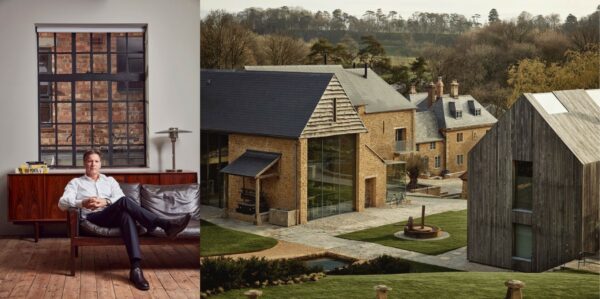
Richard Parr shot by Mark Cocksedge. // Restoration of the Farmyard at The Newt. Photo Credit: Rich Stapleton.
Can you start by telling us about your background? How did you discover architecture, and how did it come to have such an important role in your life?
I’m not sure I can say how “I discovered” architecture. I just feel that an interest in the space around me was with me from a very early age. I have a curiosity for everything, particularly the built environment. As a child my parents would take me to see buildings; holidays in Britain were peppered with visits to historical buildings and as I grew up I widened my interest to new buildings. The ’70s and ’80s were formative years for me with so much change all around. I also think a big factor is my interest in living, the experiences of life and how we can enhance and improve it through design. I think that this is why I have gravitated towards designing for specific clients, not a generic use and certainly not architecture as a pure commercial equation. I have a three-dimensional mind, so I was never going to be content with a two-dimensional career!
What was the vision behind the renovation, and how did you bring it into reality? Did you add any personal touches to the design?
The vision was a shared one and there is a wonderful synergy with the client. I did not create this alone; it was arrived at over time with my client and my team in the RPA studio. On day one there was not a fixed brief and I think that this advantage afforded to the project is instrumental in its success. We curated and created it as we went along and it was an explorative process on the site. I always start with a sketch and we then explore ideas loosely through drawings, alongside this we carefully research and analyse our sites. Agricultural buildings were, originally, built as a response to practical needs and location. Taking this function away and replacing it with a hotel use, harnessing the materials and qualities of each space for people to enjoy I guess was our vision. Creating the “reality” of a project like this is an intense focus on detail, nothing is assumed and nothing is left unresolved without designing and drawing it. Specifications and schedules are necessary but no substitute for drawing every detail …. and that is no substitute for time spent on site and my personal involvement. I visited the project literally hundreds of times throughout the construction and the rigour of my client’s delivery team, the dedication of the contractor and conversations with workers, makers and craftsmen are all part of the process. Personal touches … ? they are everywhere! My heart and soul go into the work!
How did you manage to create comfortable and somewhat modern spaces while still striving to maintain the original structure of the historical farm buildings?
Creating contemporary and relevant spaces for today is at the core of the practice. We live on a heavily urbanised island and even in what is considered ‘open countryside’ we have a concentration of buildings and very few áreas have been untouched by man. This is a reality and we see it as a positive. However, preservation merely for the sake of preservation without a critical analysis is short-changing future generations of heritage. So our approach is to start with a questioning look at what we have and our strategy is to keep and preserve only what adds value and is of architectural merit. This way we keep the spirit of a place without being manacled to the past. The void this opens up is an exciting one and it allows us to create …. it’s this factor which gives our work a modern feel. Often, we rebuild and add with reclaimed and upcycled materials but we reinvent their use, which is key to not ending up with a pastiche.
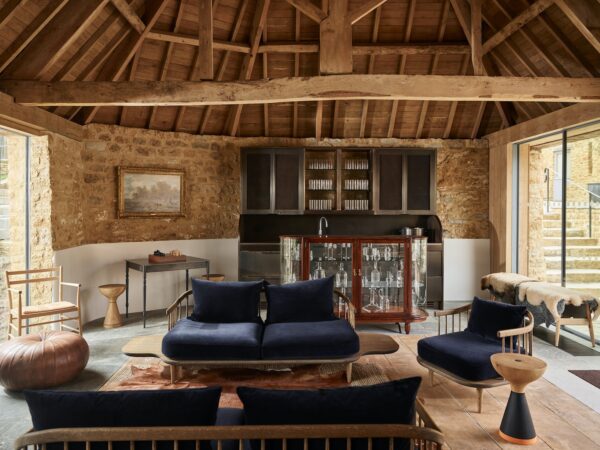
Restoration of the Farmyard at The Newt. Photo Credit: Rich Stapleton.
Can you tell us about the sustainability side of this renovation? How did you ensure the energy efficiency of the new hotel rooms, and how did the choice of materials further enforce your approach?
Sustainability is an overused and little-challenged term. The reality of regulations on modern building requires that we tackle this on energy use and efficiency, there is nothing new here. We work over and beyond this wherever we can. However upcycling materials on site, low carbon build miles, travel times and distance of workers, and life length of the building are some further areas where a difference can make a big impact. The Newt is a local employer, the majority of their 500-plus staff live within miles of the estate. We use stone from the Hadspen Quarry one mile away; every piece of material on site is looked at for re-use. Local consultants and contractors feed back into the local economy. The detailing and specification are aimed at legacy rather than short-termism. The total net effect of the above is much greater than merely taking heed to current regulations and a nod to sustainability.
Could you expand on how the local landscape and culture influenced your design choices and the selection of materials like English stones and oak timber? Do you feel like you were able to keep the soul of the farm alive?
Soul and spirit are two words, which enter conversation on all our projects. As a practice, we believe that our projects are a product of and born out of the land they sit on. The English landscape is a fascination of mine it changes every few miles and the interaction with it and the views both in and out of our buildings are carefully considered and curated. Windows are like landscape paintings from each room and our built forms are in reality, land art. We are dedicated to localism and therefore using the vernacular materials available at hand – local stone in all its forms and qualities – and local timber, we often used felled timber from the estate are just two examples. Soul is everything, without it, the guest’s experience would fail to be rich and unique. How is it done? That is a thesis in itself but I will use one example. It is the evidence of care, craft and personality everywhere. The whole team involved in a project like this invest in and leave their energy behind. Importantly the impact of Karen Roos as a collaborator and a client is ingrained and she paints her considered style and character everywhere.
Working on such old structures can be a challenge when wanting to add state-of-the-art technology. Do you have any tips on this for architecture enthusiasts out there?
My advice is to separate it and allow space for it from the start. Including technology is a project in itself, consider it from day one and have a strategy for it.
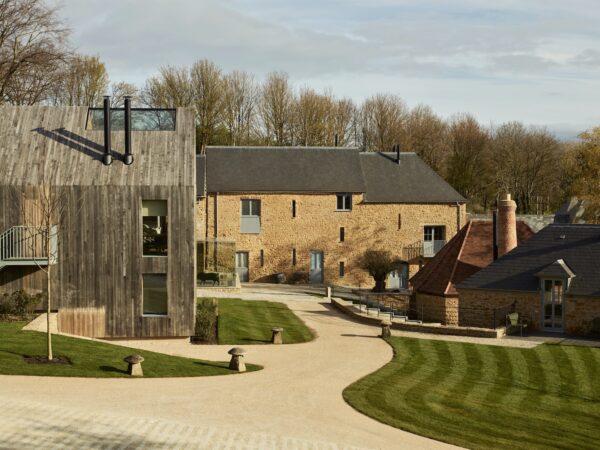
Restoration of the Farmyard at The Newt. Photo Credit: Rich Stapleton.
Congratulations on winning the Architectural Design of the Year for Living Spaces award at the LIV Awards! How does winning such accolades influence your approach to new projects?
It is an honour and a privilege to receive recognition. We don’t work or design for awards. Our values are set regardless of them, it is just very reassuring and encouraging for everyone involved when a project receives an award. So thank you for the time and effort that the judges have spent in considering our project.
We are excited to see what the future holds for your studio, Richard Parr Associates! Can you tell us about any new projects you’ve been working on?
The life of the studio is a journey. Both an exciting and challenging one. Our work with The Newt is ongoing with three new hospitality projects coming to the Estate. Firstly next year, then 2026 and 2027 will be exciting for our collaboration. Most of our work, however, comes from private residential commissions and there are a range of extraordinary sites and projects. At one extreme are several newly built country houses on previously unbuilt sites, a wine lodge and two Grade II* listed manor houses where we are breathing new life and layering a 21st-century design onto a historic fabric.

Restoration of the Farmyard at The Newt. Photo Credit: Rich Stapleton.